Chionodoxa Lucilia: description, planting and care

Among the early flowering ornamental plants, there is the Chionodox flower, which has the popular name "Snow Beauty" because it blooms when there is still snow. It may not be as famous as crocus, hyacinth and daffodil, but its decorative qualities have already been appreciated by many growers. Let us consider in more detail the description, planting and leaving of Chionodox Lucilia.
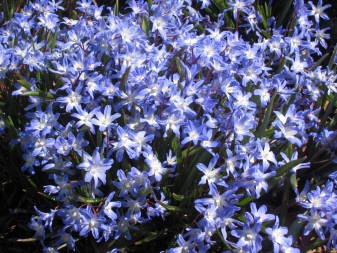
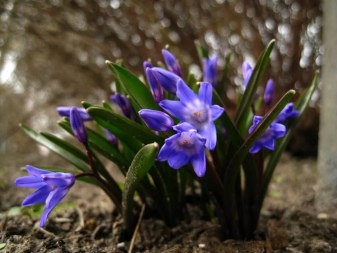
Description
Chionodoxa Lucilia is one of 6 species of this plant. The name of the flower was given by P.E.Boissier, a botanist from Switzerland, who named it after his wife. Chionodoxa is a perennial bulbous early flowering plant. In natural conditions, it grows in the western mountainous regions of Asia Minor. Chionodoxa Lucilia is a short flower, reaching a height of 10–20 cm. A distinctive feature of the flower is the tightly collected stamens of the inflorescence. Peduncles and leaves growing directly from the bulb grow at the same time.
The slender flower stem has a reddish tint.
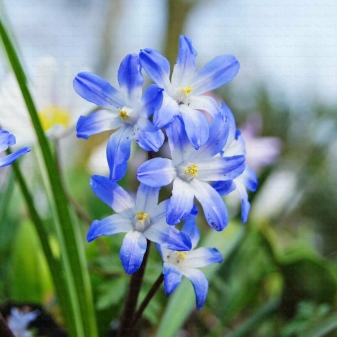
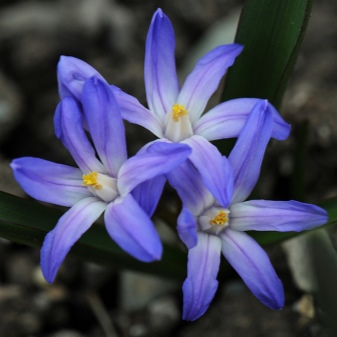
The plant has 2 lanceolate leaf plates, about 8–12 cm long and up to 2 cm wide, painted dark green. Up to 5 buds are usually formed on the peduncle. Inflorescences, collected in loose brushes, can have a different color - from milky white to blue-violet. Flowers with pointed petals are medium-sized - up to 3.5 cm in diameter. Chionodoxa giant has the largest flowers - up to 4 cm. Flowering lasts about 3 weeks, after which fleshy fruits in the form of a capsule are formed, containing large black seeds with soft appendages. Small in size (about 3 cm in length and up to 1.7 cm in diameter), light-scaled bulbs have a round or elongated ovoid shape. They form the root system of a one-year cycle.
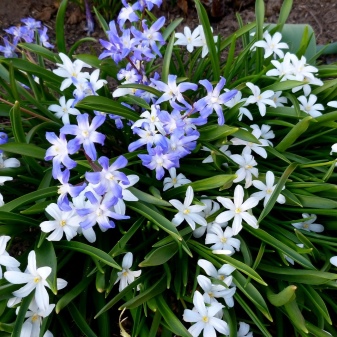

Varieties
In total, there are 6 species of this plant, very similar in appearance, but with some distinctive features. Let's take a closer look at the most popular flower varieties.
- Chionodox Forbes. This early flowering plant is a primrose with delicate inflorescences. The bulb can form 2-3 glossy sheets of a linear shape with a rich green hue. Pedicels, reaching a height of 15–25 cm, bear an inflorescence-raceme, including from 4 to 10 flowers with 6 elongated petals, painted in delicate blue tones. The diameter of the flowers is about 2.5 cm. The color from white at the core gradually turns into a deep blue tint along the edges of the petals.
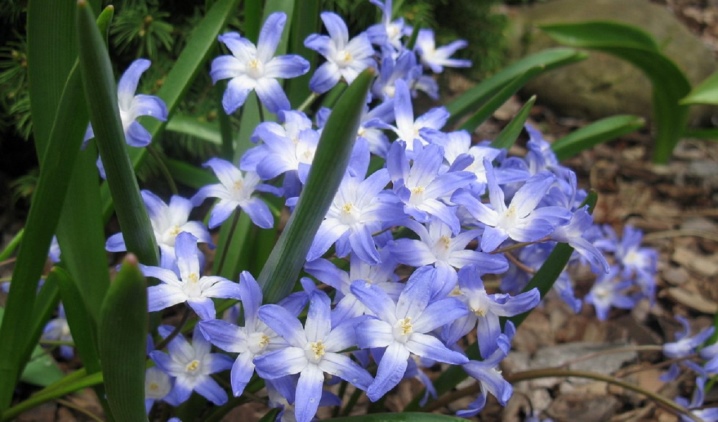
- Sardinian (sardensis). It is a stunted plant with linear leaves painted in bright green. The peduncle can reach a height of 15 cm. Small flowers are distinguished by a gradual transition from dark blue to a light cream shade in the center of the bud. Flowering lasts about 2 weeks. A round-shaped brown bulb covered with scales is approximately 2 cm in size.
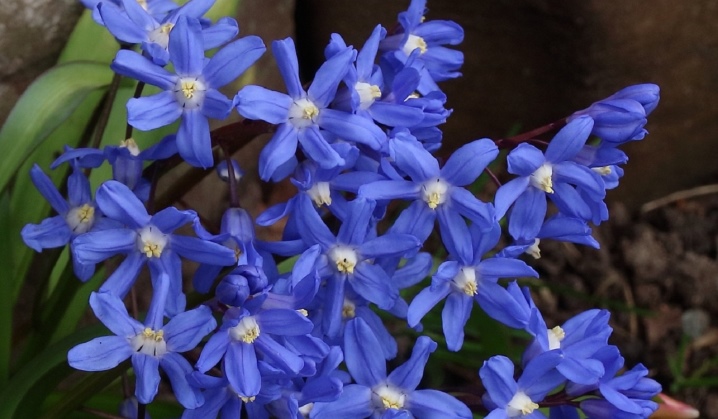
- Giant. The narrow, linear leaves are 9–12 cm long and have a deep green color. Paired flowers may have shorter peduncles on which large (up to 4 cm in diameter) buds are formed. The flowers are colored blue or lilac, which, gradually lightening, acquires a whitish tint at the core. The bulbs are 1 to 3 cm in diameter. The flower blooms in March and April for 3 weeks.
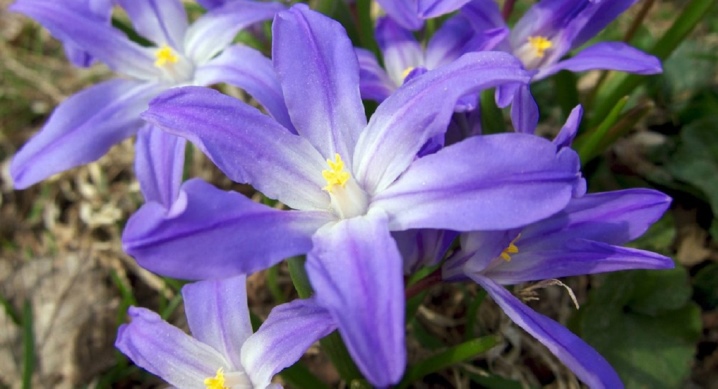
Important! Other types of flower - Chionodoxa Cretan or dwarf, white and Mrs. Lok - are practically not grown as cultivated plants in horticulture. These species are used to breed new varieties.
On the basis of all these plant varieties, many varieties have been bred. Let's consider the most popular ones.
- Blue Giant. Perennial plant with upright, linear leaves and small bright blue flowers with a white center. The peduncle reaches a height of 15 cm and bears dense clusters of inflorescences containing from 5 to 8 buds.
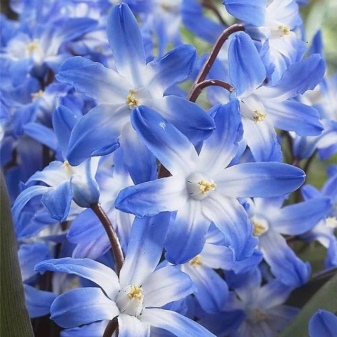

- Violet Beauty. A low-growing variety, only 10–12 cm high, it has bell-shaped buds with delicate purple petals and a milky throat. The flowers are large, reaching 4 cm. Up to 10 buds are formed on the peduncle, which are either collected in a brush, or are located singly. The leaves have a dark green color. It blooms in April and May.
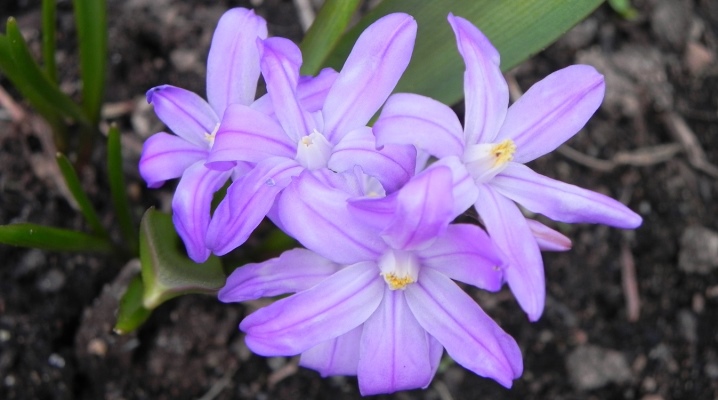
- Alba. The plant, about 14 cm high, has straight, linear leaves. The inflorescences are pure white or milky, and the core is yellow. A characteristic feature of the variety is the slightly corrugated and curled petals of the bell-shaped inflorescences. Small flowers, about 2 cm in size, are collected in loose clusters. This variety blooms in April and May.
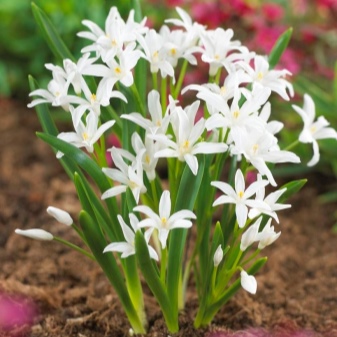
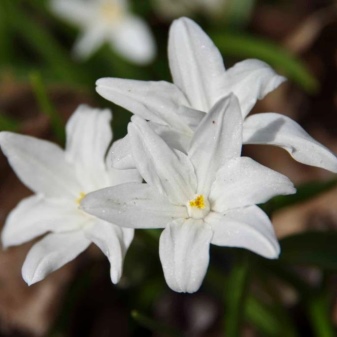
- Pink Giant. This variety of Chionodox, reaching a height of 20 cm, is distinguished by inflorescences with a delicate color of lavender-pink hue. The flowers have a graceful shape in the form of stars with 6 petals and a convex core. The size of the bud is about 3 cm. Each stem bears up to 10 inflorescences. Flowering occurs in April or May and lasts quite a long time - up to 4 weeks.
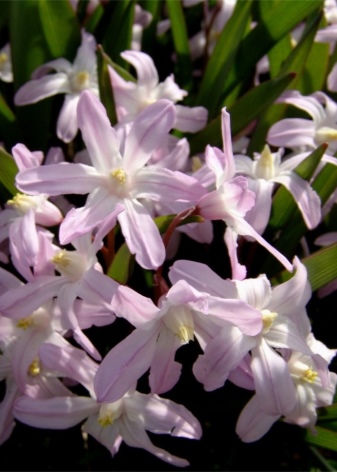
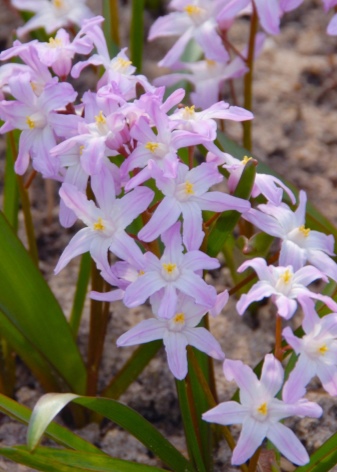
- Blue White. A tall variety, the bushes of which can reach a height of 25 cm. Peduncles bear large blue flowers with a white core.
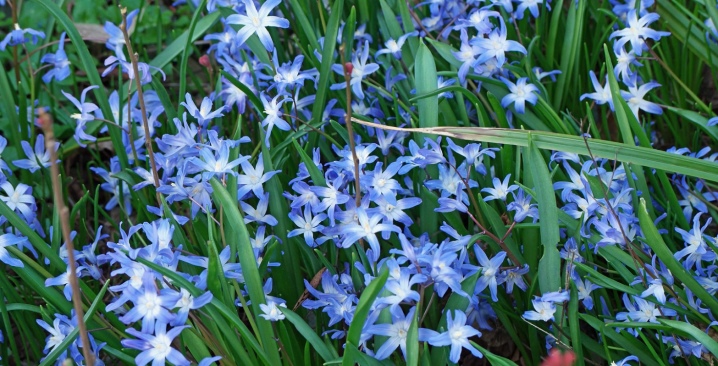
- Rosea. A plant with a height of about 25 cm can have about 15 pink buds on a pedicel, ranging in size from 1 to 3.5 cm. The snow-white color of the core stands out in contrast to the pink background with a purple shade of the petals.
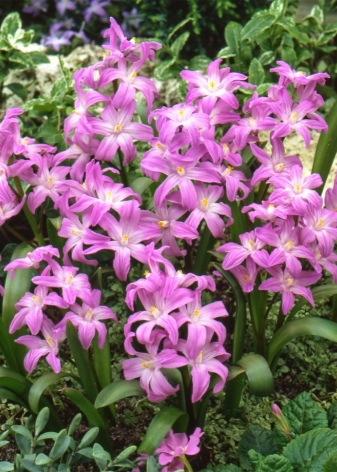
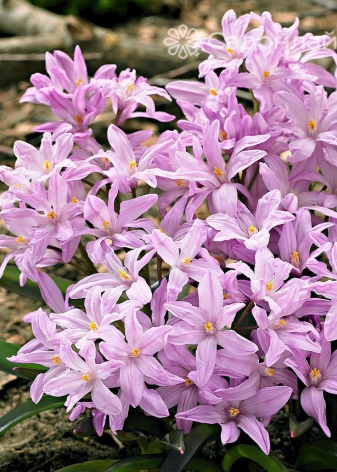
- Quinn. The variety is characterized by flowers densely sitting on a peduncle with petals painted in delicate pink tones, and brightly distinguished yellow stamens. The inflorescence consists of 5 or 6 buds. The green leaves are brown in color.


- "Watercolor". These chionodoxes are distinguished by the clear blue color of the star-shaped inflorescences. The white core blends beautifully with the blue background of the petals. A short bush can reach a height of 10 cm.
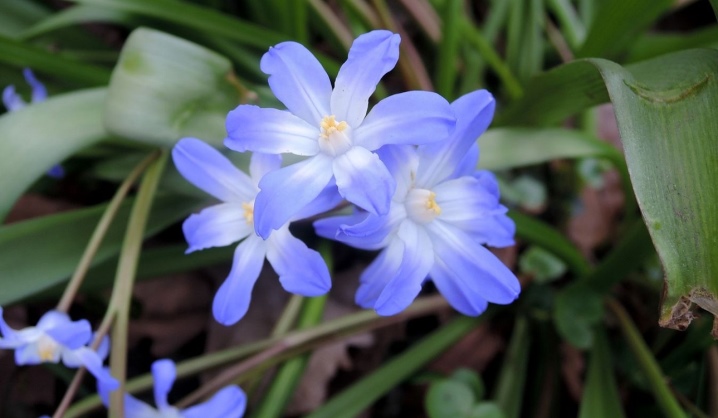
- "Mixture". A distinctive feature of the plant is the multi-colored flowers on the peduncle of one bush. The buds can have lilac, blue, pink, purple colors. The dark green leaves have pointed tips.
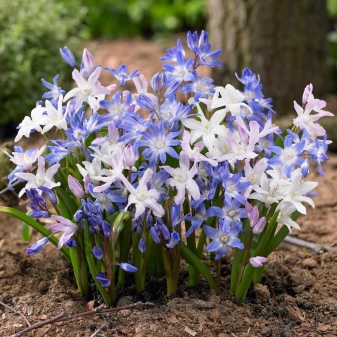
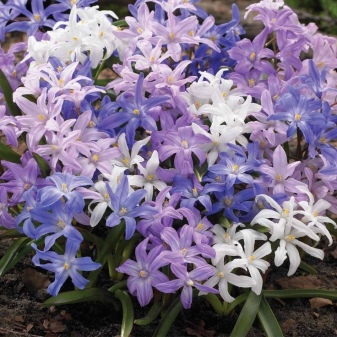
- The Pink Giant. Variety with delicate pink buds and a lighter heart.
In a plant up to 15 cm high, the pedicel bears an inflorescence, consisting of 3-4 flowers.
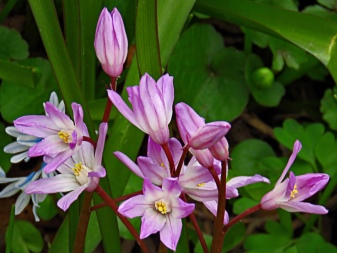
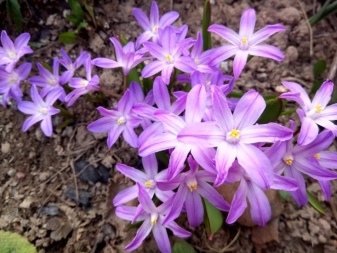
In addition to these varieties, chionodoxes such as:
- "Artemis" with small blue flowers;
- "Absolute" with bright blue inflorescences and a pale pharynx;
- "Atlantis" with petals of a very light transparent blue hue, yellow stamens and lush inflorescences;
- "Arctic" with snow-white flowers.

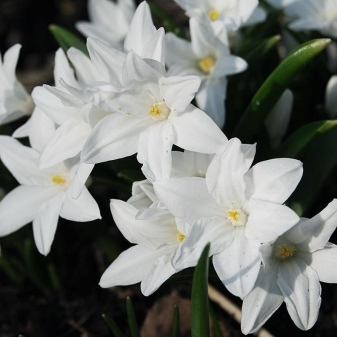
How to plant?
Autumn is the best time to plant flower bulbs. Usually they are planted in the first half of September. By this time, root ridges have already been formed on the bottom. During the autumn period, the bulbs will be able to gain strength for further growth and flowering in the spring.
Chionodoxa is an unpretentious plant that can grow successfully anywherebut it especially prefers areas with good lighting, although it can grow in partial shade. In sunny places where the snow melts faster, Chionodoxa blooms earlier than a flower planted in shady places, although here it will bloom for a longer time. An important role is played by the proximity of the plant with other flowers.The development of chionodoxa is favorably influenced by the proximity to primroses and crocus, iris and hyacinth, adonis and hellebore. Chionodoxa also grows well under deciduous shrubs and trees.
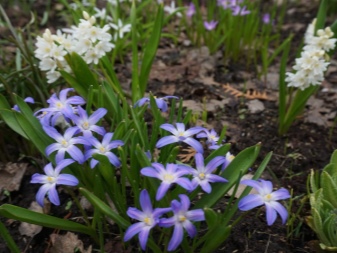
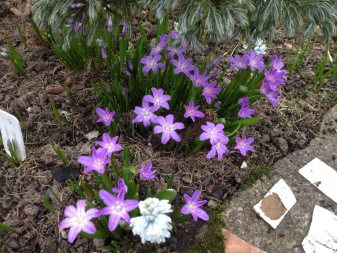
When landing, you must adhere to some requirements.
- Priming. The flower prefers nutritious loose soil, moderately moist and having a neutral environment. The growth of the plant is badly affected by clay and acidic soil, as well as excessively moist soil. When planting, it is recommended to add humus from leaves and bark of trees or forest soil to the soil.
- Planting depth. It should match the size of the bulb. Large specimens are planted at a depth of about 6–8 cm with a distance between holes of about 8–10 cm. Small bulbs are placed at a depth of 4–6 cm with a slightly smaller gap - from 6 to 8 cm.
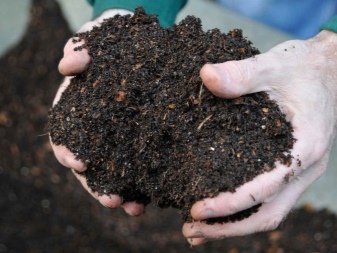
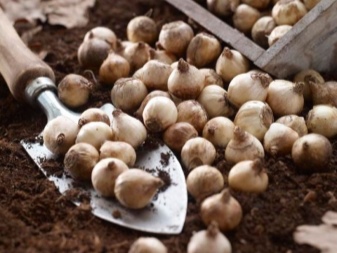
Important! After planting the bulbs, you need to apply fertilizers containing nitrogen.
Follow-up care
Growing an unpretentious plant in the open field does not require complex care. The usual agricultural practices should be followed.
Watering
One of the conditions for successful plant growth is compliance with the watering regime. The plant reacts negatively to the lack of natural moisture. However, watering in spring is only necessary in case of a snowless winter or dry spring. With abundant melting of snow, when the ground is well saturated with moisture, watering can be omitted.
During the growing season, watering should be regular and abundant, but not excessive. Water as needed, preventing the soil under the plant from drying out. During dry periods, the flower should be watered more frequently. For irrigation, you need to use settled or rainwater. After flowering, watering is carried out less often.

You need to water the plant under the root system, preventing water from getting on the leaves and inflorescences. The best time to water is in the morning or evening. (after sunset). Watering is accompanied by loosening the soil under the plant. Mulch made from organic fertilizers or peat helps to retain moisture.
Top dressing
The abundance of flowering directly depends on the availability of nutrients in the soil, therefore it is so important to periodically apply additional fertilizing. In the spring, during active growth, it is necessary to introduce nitrogen-containing agents, for example, nitroammophoska. Complex mineral fertilizers have a beneficial effect on the development and flowering of chionodoxa. Fertilizers can be applied both dry and liquid. Dry fertilizers in the form of granules are evenly scattered near the flower, after which the soil should be loosened: this way the nutrients will quickly enter the root system. For the whole season, it is recommended to carry out 2-3 additional feeding.

Weeding
Weed control is essential because it depletes the soil by absorbing nutrients from the soil. Weeding is carried out as weeds grow, combining it with loosening the soil. This is recommended after rain or watering. Mulching the ground under the plant prevents weeds from growing.
Chionodox care also includes a timely plant transplant. A flower can grow in one place for about 10 years. However, flower growers recommend replanting the plant periodically (after 5–6 years). The bulbs are dug out of the soil as soon as the green mass of the flower turns yellow and begins to dry out. This usually happens in mid-July.
Children should not be separated from the mother's bulb before planting in the ground, since the separated medium-sized bulbs may die. The removed bulbs are stored in a dry, dark and cool place.
In the first half of September, after separating the children, the bulbs are planted in a permanent place.
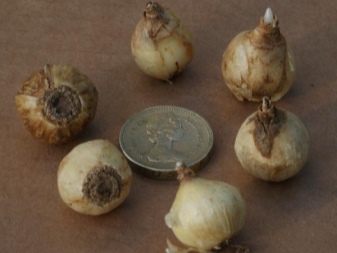

Preparing for winter
After the flower has faded, the wilted stalk should be cut off, but the leaves should be left. They are removed only after complete wilting. It is not recommended to cut the foliage before it is completely dry. You can periodically remove only those wilted leaves that are easily removed from the soil.This will keep the plant looking attractive.
The flower has good resistance to cold, so bulbs do not need to be dug out for the winter in the fall. The flower tolerates frost well without shelter. Only chionodox growing in open areas, unprotected from drafts, should be sheltered. They are covered with dry leaves, moss, spruce trees.

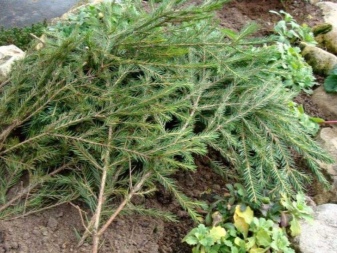
Disease and pest control
Chionodoxa is susceptible to the same diseases as other bulbous plants, for example, hyacinth, tulip, daffodil. Most often, the flower suffers from the following diseases, which are the result of fungal infections:
- gray rot occurs when the soil is waterlogged, it affects the bulb - it rots; foliage and buds are covered with a grayish bloom, and then they turn yellow and dry out;
- fusarium - this disease has a focal form of spread, affecting primarily the root system; the symptoms of this fungal disease are the appearance of dark spots on the leaves, which eventually turn black, dry out and fall off;
- septoria - you can find a diseased plant by the gray-brown or rusty plaques with a yellow border that appear on the leaves, then black dots appear in the center of the spots - pycnidia (fruiting bodies of the fungus); growing gradually, the infection affects the entire surface of the leaves;
- sclerotinosis - this disease affects the flower stem: watery spots appear on it, which, gradually increasing, lead to rotting of the pedicel, then the leaves and bulb are affected; it is very difficult to find a sick flower at the initial stage; the affected plant does not develop well, its leaves begin to turn yellow prematurely, it is no longer possible to cure a flower with such symptoms: it should be dug up and destroyed.

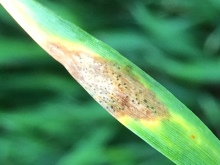
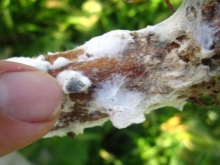
To prevent these diseases, the bulbs must be treated with a solution of the drug "Fundazol" before planting, fungicides ("Fitosporin-M", "Fitolavin") should be added to the soil, and at the beginning of the growing season, spray the flower with such fungicides as "Aktara", "Akarin" , "Actellic".
And also it is impossible to allow waterlogging of the flower during watering, which causes rotting of the root system and bulbs.
The ground parts of the plant are less susceptible to attack by pests. This is due to the fact that the development and flowering of the plant occurs in early spring, when the insects have not yet appeared. The most dangerous pests for chionodox are the larvae of the meadow tick and rodents - mice, moles. The meadow mite lays its larvae in the ground, which use the roots of growing plants for nutrition. They infect chionodox bulbs, eating them from the inside, and as a result, the bulbs die. To prevent the appearance of these pests, it is necessary to spray with acaricides at the very beginning of the growing season. Rodents also damage the bulbs. To combat them, bait with poison is used, which are placed on the site.
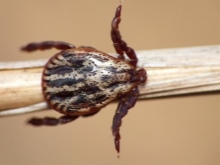


Reproduction
The most popular way of reproduction of chionodoxa is the vegetative method - with the help of the babies of the mother's bulb. Usually up to 4 young onions are formed per season. Reproduction by children is carried out in the same way and at the same time as a flower transplant.
Another way is seed propagation. Spontaneous reproduction of the plant often occurs. From ripe and burst fruits, seeds fall into open ground. The fleshy appendages on the seeds are a bait for ants to carry seeds throughout the area. Soon the flower can grow in any unexpected place.
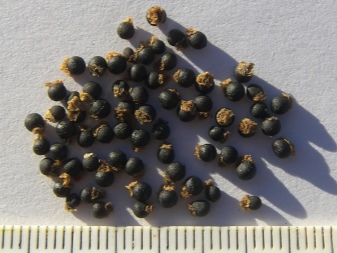
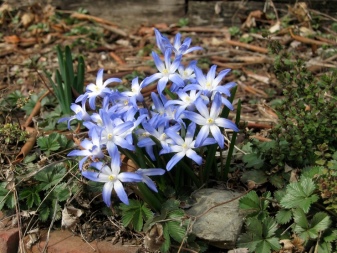
In order to prevent spontaneous and unwanted reproduction, ripe seed pods must be cut off in time. Planned seed propagation is carried out as follows:
- the collected seeds must be dried and stored in a cool dry place; sowing seeds is carried out at the end of September or in October;
- seeds can be planted directly into the ground, the soil should be well dug up, the surface should be leveled and shallow holes should be made; seeds are sown in them, then they are covered with earth from above and the crops are moistened from a sprayer;
- in winter, the beds must be covered with a large layer of snow.
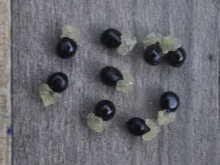
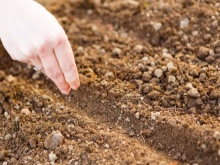

The collected seeds can also be sown on seedlings, which are grown at home, and in the spring they are planted in a permanent place in the ground.
Chionodos, grown by seed, begin to bloom only after 2 years.
Examples in landscape design
The decorative qualities of the unpretentious early flowering chionodox are used in the design of any landscapes. Blue-violet and blue flowers look delicate against the background of still unmelted snow. Most often it is used for the following purposes:
- for decoration of alpine slides or natural rockeries;
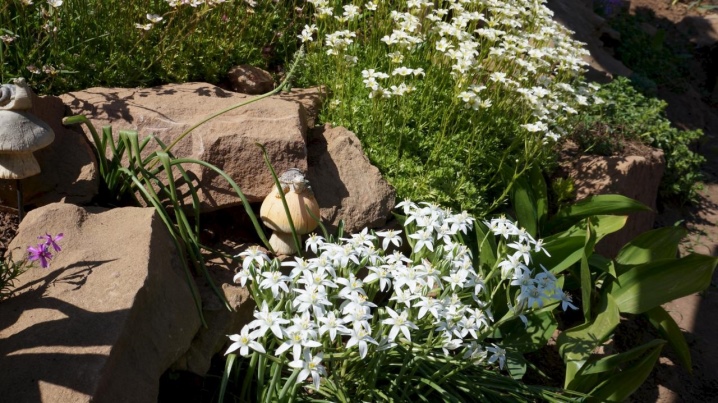
- to create spring meadows under trees and shrubs and decorate lawns - in this case, chionodox is planted linearly in several rows;
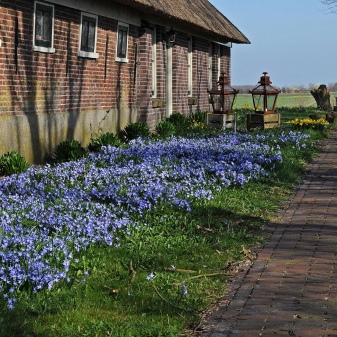

- in group compositions on flower beds, where it can be combined with other primroses, especially those with contrasting colors, for example, primroses, crested beetles, anemones.
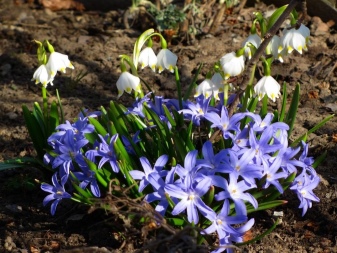
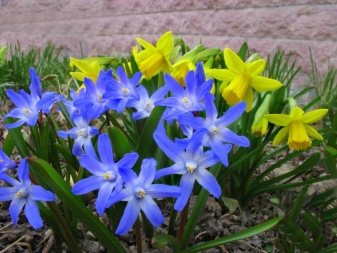
In addition, chionodox bushes look great both planted separately, and as curbs along paths, and near the walls of buildings.
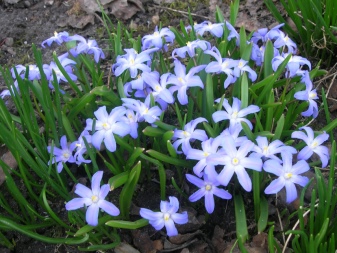
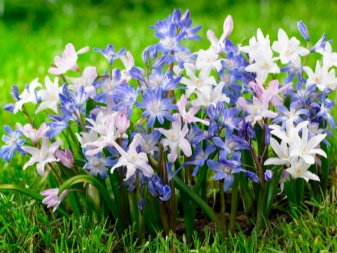
For more information on Chionodox, see the next video.







































































































The comment was sent successfully.